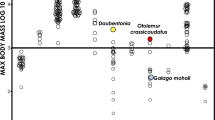Summary
-
1.
The response of the echolocating bat,Megaderma lyra, was tested to different kinds of prey in an outdoor cage. The bats caught larger flying insects (moths, beetles, grasshoppers, and cockroaches) on the wing and also picked up arthropods (solifugid spiders, beetles and cockroaches) and small vertebrates (mice, fishes, frogs and geckoes) from the ground. After touching the prey with the muzzle, the bats were able to differentiate between species. Scorpions and toads were not taken byM. lyra.
-
2.
In lighted and in dark conditions,M. lyra detected and caught prey only when it moved. Dead frogs briskly pulled over the floor were also detected and caught, whereas stationary dead frogs were disregarded by the bats (Table 1).
-
3.
When dead frogs were pulled over the watered surface of a glass plate to eliminate noises by motion, the motion no longer alarmed the bats. From the results of these experiments it was concluded thatM. lyra detects prey on the ground by listening to the noise of the moving target only, and not by echolocation (Table 1 C, Fig. 1). Furthermore,M. lyra were not attracted by frog calls.
-
4.
M. lyra differentiated between palatable frogs and non-palatable toads only after touching the prey with the muzzle.
-
5.
Experiments with freshly killed frogs coated with toad secretions or covered with toad skins indicate thatM. lyra differentiates between frogs and toads by chemical means. There was no evidence that these prey were differentiated by means of echolocation.
Similar content being viewed by others
References
Advani R (1981) Seasonal fluctuations in the feeding ecology of the Indian False Vampire,Megaderma lyra lyra. Z Säugetierk 46:90–93
Bell GP (1982) Behavioral and ecological aspects of gleaning by a desert insectivorous bat,Antrozous pallidus. Behav Ecol Sociobiol 10:217–223
Fenton MB (1984) Echolocation: Implications for ecology and evolution of bats. Q Rev Biol 59:33–53
Fiedler J (1979) Prey catching with and without echolocation in the Indian False Vampire (Megaderma lyra). Behav Ecol Sociobiol 6:155–160
Habersetzer J (1983) Ethoökologische Untersuchungen an echoortenden Fledermäusen Südindiens. Dissertation Thesis, Faculty of Biology, University of Frankfurt
Habersetzer J, Vogler B (1983) Discrimination of surface-structured targets by the echolocating bat,Myotis myotis during flight. J Comp Physiol 152:275–282
Kulzer E, Nelson JE, McKean JL, Möhres FP (1984) Preycatching behaviour and echolocation in the Australian ghost bat,Macroderma gigas. Aust Mammal J 7:37–50
Möhres FP, Neuweiler G (1966) Die Ultraschallorientierung der Großblatt-Fledermäuse (Megadermatidae). Z Vergl Physiol 53:195–227
Neuweiler G, Satpal Singh, Sripathi K (1984) Audiograms of a South Indian bat community. J Comp Physiol A 154:133–142
Payne R (1971) Acoustic location of prey by barn owls (Tyto alba). J Exp Biol 54:535–573
Ryan MJ, Tuttle MD (1983) The ability of the frog-eating bat to discriminate among novel and potentially poisonous frog species using acoustic cues. Anim Behav 31:827–833
Ryan MJ, Tuttle MD (1987) The role of prey-generated sounds, vision and echolocation in prey localization of the African batCarcioderma cor (Megadermatidae). J Comp Physiol A (in press)
Schmidt S, Türke B, Vogler B (1984) Behavioral audiogram from the batMegaderma lyra. Myotis 22:62–66
Suthers R (1965) Acoustic orientation by fish-catching bats. J Exp Zool 158:319–348
Tuttle MD, Ryan MJ (1981) Bat predation and the evolution of frog vocalizations in the neotropics. Science 214:677–678
Vaughan TA (1976) Nocturnal behavior of the African False Vampire bat (Cardioderma cor). J Mammal 57:227–248
Vaughan TA, Vaughan RP (1986) Seasonality and the behavior of the African yellow-winged bat. J Mammal 67:91–102
Author information
Authors and Affiliations
Rights and permissions
About this article
Cite this article
Marimuthu, G., Neuweiler, G. The use of acoustical cues for prey detection by the Indian False Vampire Bat,Megaderma lyra . J. Comp. Physiol. 160, 509–515 (1987). https://doi.org/10.1007/BF00615084
Accepted:
Issue Date:
DOI: https://doi.org/10.1007/BF00615084




